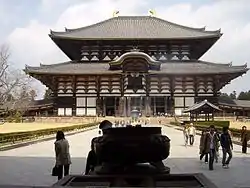Bodhisena
Bodhisena (Tamil: போதிஸேன; Chinese and Japanese: 菩提僊那; 704–760) was an Indian Buddhist scholar and monk known for traveling to Japan and establishing the Kegon school, the Japanese transmission of the Huayan school of Chinese Buddhism.
| Part of a series on |
| Buddhism |
|---|
 |
|
His stay has been noted in the official history records called the Shoku Nihongi, where he is referred to as Bodai-Senna.
Early years
Bodhisena was born in Madurai around 704 AD. He got mystical inspiration from Manjusri Bodhisattva. He initially went to China, having heard that he could meet the incarnation of Manjusri at Mount Wutai. However, on reaching Mount Wutai, he was told the incarnation was in Japan. He also became acquainted with the tenth Japanese ambassador to China, Tajihi no Mabito Hironari.[1] He also met the Japanese monk Rikyo.
Voyage to Japan
On the invitation of Emperor Shōmu, he visited Japan to spread the use of Tamil and establish Huayan Buddhism in the country. He traveled with the Japanese delegation of Tajihi no Hironari,[2] via Cambodia and Champa in Vietnam.
On the same ship were other important historical figures.
They included the traveling companions Genbō and Kibi no Makibi. Genbo was a monk and was returning from China with the over 5,000 fascicles that made up the Chinese Buddhist Canon. Kibi brought with him the arts of embroidery, playing the lyre, and the game of Go.
Life in Japan
The party arrived at Naniwa (Osaka) in August 736 and was met by the monk Gyoki.[3]
According to a number of sources, Gyoki and Bodhisena recognised each other from a past life. According to the Shūi Wakashū, quoting from the Tōdaiji Yōroku, Gyoki stated that they were together at Vulture Peak when the Buddha preached the Lotus Sutra. Bodhisena, called the "Baramon Sojo" (Brahmin Priest), additionally refers to them being together at Kapilavastu. He also recognised Gyoki as the rebirth of the boddhisatva Manjusri he was seeking. Their exchange is recorded thus:[4]
Gyoki:
- On the Holy Mount,
- In the presence of Sakya,
- The self consistent
- Truth we swore has not decayed:
- I have met with you again!
Baramon Sojo in reply:
- The vow we swore
- Together at Kapilavastu
- Has borne fruit:
- For the face of Manjusri
- I have seen again today![5]
Gyoki conducted Bodhisena to Nara and presented him to the emperor. He was treated with great honour and lodged in the temple called Daian-ji, where he founded Kegon Buddhism and also taught Tamil
In 752, Emperor Shōmu asked him to perform the eye-opening ceremony for the giant bronze statue of the Buddha Vairocana built in Tōdai-ji. Dosen also played a significant role. The painting of the eyes was done by Bodhisena.
After a visit to Mount Tomi (Nara), Bodhisena petitioned the emperor to name the prayer hall there Ryōsen-ji (霊山寺), as he found the place to strongly resemble the mountain in India where the Buddha preached, known as Vulture Peak, or Ryoujusen (霊鷲山) in Japanese.
Bodhisena resided in Daian-ji (大安寺) in Heijō-kyō for the rest of his life. He died on February 25, 760 at Daian-ji temple, and was buried on the Ryoujusen (霊鷲山) mountain, following his wish when he died.

Legacy
Japan’s traditional court dance and music still preserve some of the forms introduced by Bodhisena into Japan.[6]
The forty-seven characters of the Japanese script are said to have been devised after the pattern of the Tamil alphabet by the Japanese Buddhist Kobo Daishi (774-835 AD). The arrangement of the Japanese syllabary based on the Tamil system is also attributed to the influence of Bodhisena in Japan, which, according to Riri Nakayama, “will continue as long as the Japanese language continues to exist”.[6]
External links
- Daian-ji, Japan (in Japanese)
- Ryōsen-ji, Japan (English summary)
- Tōdai-ji, Japan (in Japanese)
References
- Ambassadors from the islands of immortals: China-Japan relations in the Han-Tang period by Zhenping Wang, page 167
- Music from the Tang Court By Laurence Picken, Laurence Ernest Rowland Picken, R. F. Wolpert, page 31
- Japanese Buddhism By Charles Eliot, page 225
- A Waka Anthology Volume Two: Grasses of Remembrance
- Buddhist hagiography in early Japan: images of compassion in the Gyōki tradition By Jonathan Morris Augustine, page 108
- Cultural Contacts between BIMSTEC Countries and Japan: An Historical Survey by Sanjukta Das Gupta, CSIRD Discussion Paper: 7/2005, November 2005, (pages 5-6)